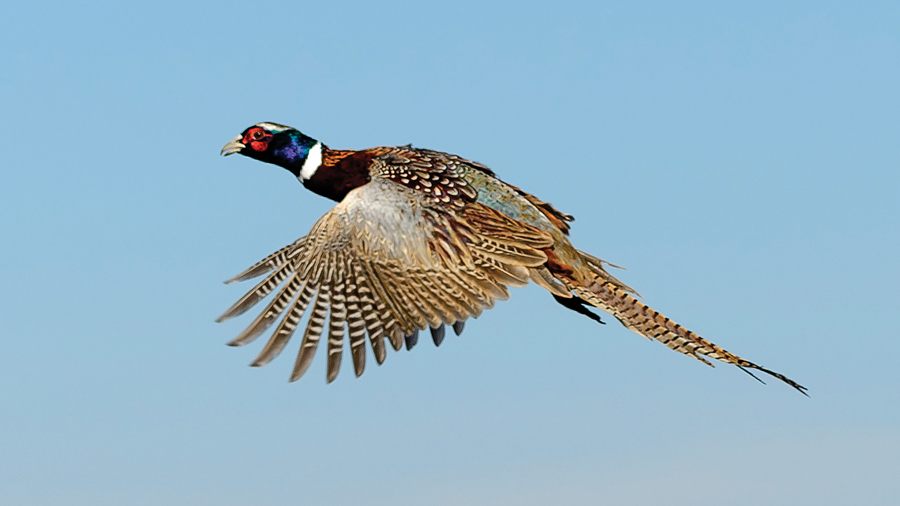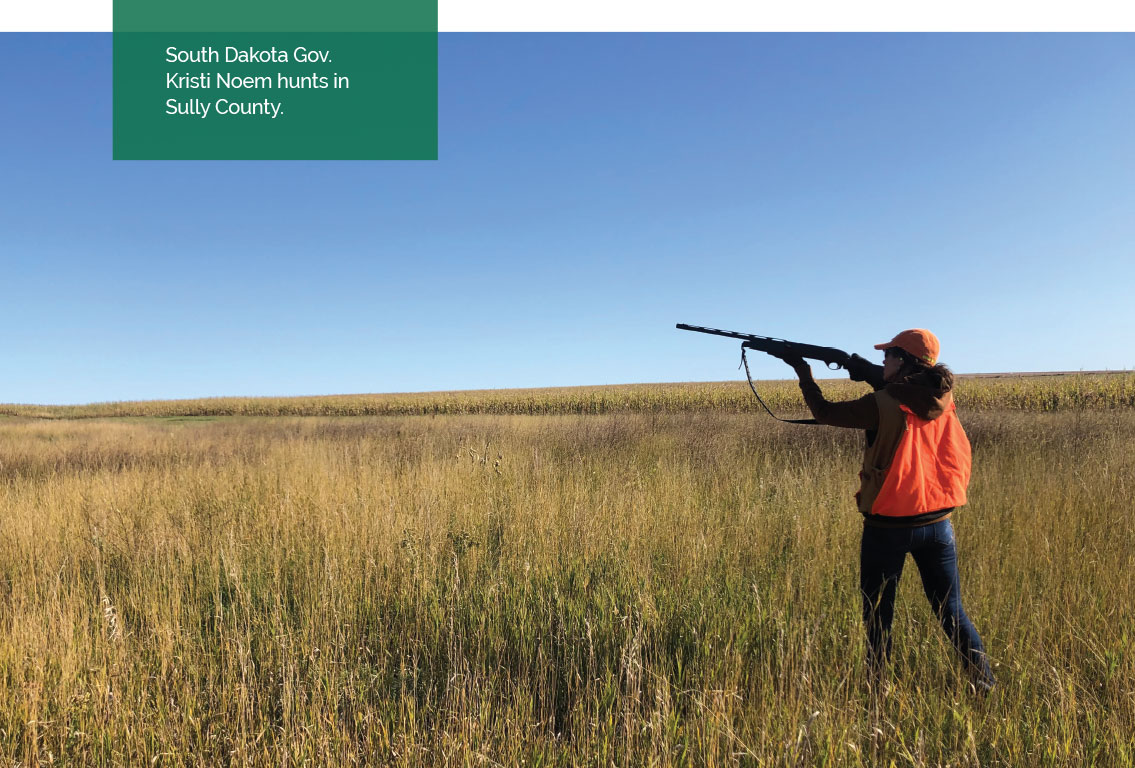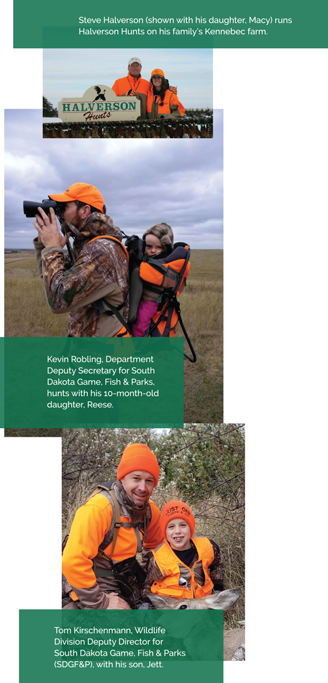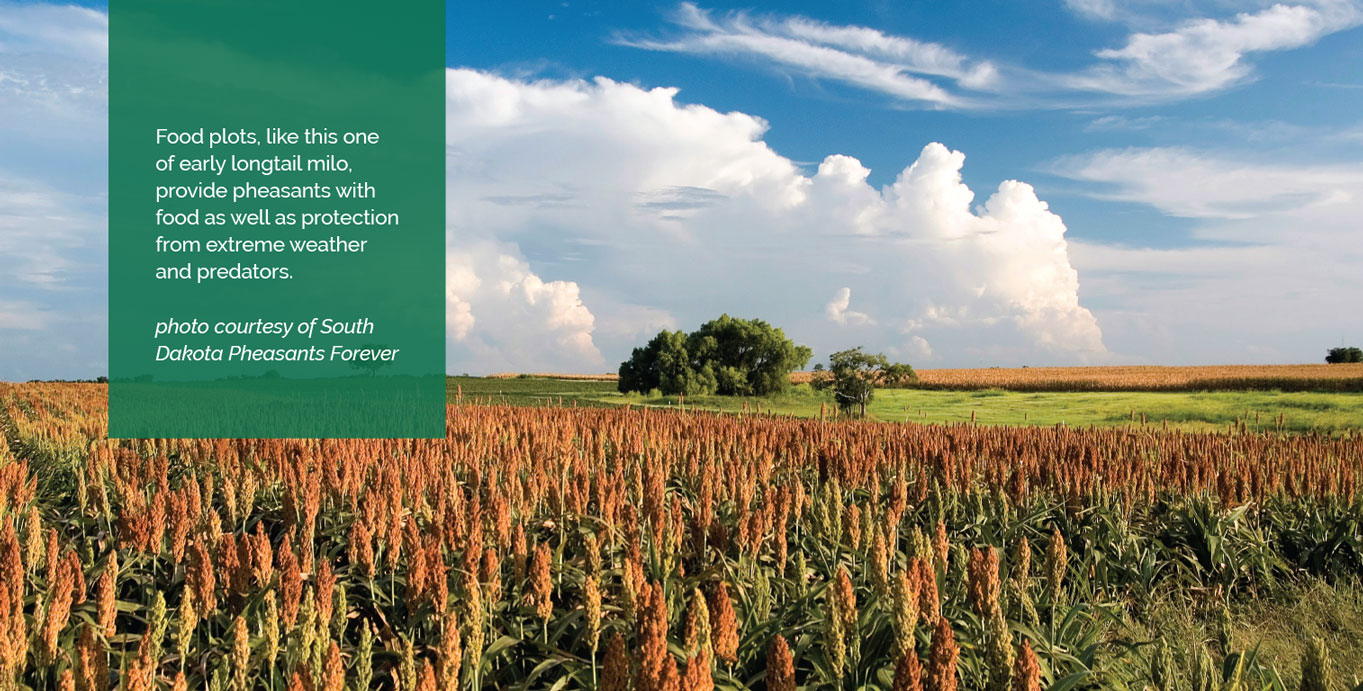photo courtesy of South Dakota Dept. of Tourism
Farm work kept Steve Halverson’s dad busy from dusk till dawn, but each fall, Harlan took a break from harvest to take Steve hunting.
“Dad taught me how to shoot and a few times a year, he took me hunting. Opening day, big parties of friends would come in, and Dad often took that day off from farming to enjoy time with friends and family. I would go along, packing my BB gun, thinking I shot every bird that fell,” recalls Halverson, a fourth-generation Kennebec, S.D., farmer.
Located on the rolling hills of central South Dakota, pheasants thrive on Halverson’s family farm, where the family has focused on increasing pheasant habitat for more than three decades. “Hunting is something I’ve always enjoyed. It’s something my generation grew up doing.”
And more than 63,000 South Dakotans and 84,000 non-resident pheasant hunters would agree. “Hunting is part of our South Dakota way of life,” says South Dakota Gov. Kristi Noem.
To preserve South Dakota’s hunting tradition, Noem launched the Second Century Initiative during Legislative Session 2019 and signed Senate Bill 176 into law. The bill allocates $1 million to expand pheasant habitat and hunting opportunities through the Second Century Habitat Fund.
A long-standing South Dakota tradition, pheasant hunting is integral to the state’s economy. The sport connects rural South Dakota with visitors from across the nation who spend more than $175 million each year.
“The first century of pheasant hunting put South Dakota on the map as a destination for every hunter. We must now preserve and expand habitat to ensure that the second century of pheasant hunting will be as great as the first,” Noem explains.
Why Habitat Matters
Preservation and habitat development are top of mind after South Dakota’s pheasant population dipped in 2017 to a record low of about 4.6 million in response to drought and severe winter weather conditions.
Hunters took notice. In 2017, there were 16 percent fewer pheasant hunters than 2016.
“There is a direct correlation between pheasant population and participation in the sport. When populations are strong, we see more hunters participating. When populations are down, we see less participation,” says Tom Kirschenmann, Wildlife Division Deputy Director for South Dakota Game, Fish & Parks.
A diverse and innovative program, Second Century Initiative is designed to engage the next generation of South Dakota youth and families in hunting and other outdoor activities, while at the same time bolster pheasant numbers by increasing habitat statewide.
“Habitat is key to affirm and sustain the heritage of pheasant hunting which runs deep in South Dakota,” Kirschenmann says.
In 2007, when South Dakota’s pheasant populations reached 11.9 million, available habitat was abundant, with more than 1.7 million acres of private land enrolled in the Conservation Reserve Program (CRP). Today, about 1 million acres are enrolled, and pheasant populations are less than half. Kirschenmann explains that while extreme weather events like flooding, blizzards or drought impact pheasant populations, if the right habitat is available, birds rebound quickly.
The right habitat for pheasants allows them to successfully build a nest, hatch a clutch of eggs and raise a brood, as well as provides them with food and protection from predators, extreme heat and cold. “Their entire lifecycle revolves around available habitat,” Kirschenmann says.
Pheasant’s habitat needs vary. For nesting, pheasants need undisturbed grassland habitat. When it comes to predator protection and winter survival, they need woody habitat (shelter belts) or cattail sloughs, corn or sorghum stalks, which provide food as well as thermal cover.
“They like habitat with plenty of edges,” is the simple way Matt Morlock, State Coordinator for Pheasants Forever, explains it. “Pheasants like to hang out and nest in low cover, but they don’t want to be too far away from the security of tall, heavy cover in case a predator comes around.”
Because more than 80 percent of land in South Dakota is privately owned, landowner buy-in is essential to increasing pheasant-friendly habitat statewide. This is where the Second Century Working Lands Program comes in. The five-year incentive program pays South Dakota farmers and ranchers a one-time incentive payment of $150 an acre to plant marginal crop acres to grassland.
Working Lands Program Incentivizes Preservation
Funded by the Second Century Habitat Fund, grass seed mixes are provided to private landowners at no cost. Once the grass stand is established, landowners may hay or graze enrolled acres.
“We emphasize the (working) focus of this program. The Governor recognizes producers need a habitat program to fit within their existing operation and allow them to continue to use enrolled acres for livestock,” Kirschenmann explains.
Halverson is impressed by the program’s flexibility. “Game, Fish & Parks get the big picture of how important farmers and ranchers are to wildlife in the state,” says Halverson, who was asked by Noem to serve on the board for the Second Century Habitat Fund.
Halverson began researching ways to increase pheasant habitat on his family’s farm in the mid-80s to increase pheasant populations to support their growing day-hunt business. “Back when I was in college at South Dakota State University, I would go to the library and do research on wildlife habitat,” he says. “I knew I was going to return to the farm and envisioned expanding our commercial hunting business here.”
Halverson Hunts began with four or five day-hunts a season and has grown to more than 400 hunters returning each season. Halverson and his parents began converting marginal, non-productive crop acres to native grasslands, enrolling those acres in CRP.
“I read an article that said 40 to 50 acres of CRP, in the right spot, will produce as many pheasants as 500 acres of open prairie,” Halverson says.
Halverson provides his pheasants with ideal habitat by planting marginal, low-producing areas of crop ground to native grassland. He increases winter food and cover by planting 160 acres of sorghum food plots in 2 to 8-acre plots. “I’m a believer in taking marginal farm ground out of production and putting it into CRP or other conservation programs. The pheasant numbers explode.”
His conservation efforts don’t stop there. Halverson added several woody shelter belts. And since the mid-90s, he has managed his crop acres with no-till farming practices.
“Production agriculture and conservation can go hand-in-hand. When I make a decision on my farm, I try to find practices that are good for pheasant habitat and production. My goal is to find things like no-till that benefit both. No-till is good for soil health and leaves more cover on the fields for wildlife and grazing cattle.”
Even with an emphasis on habitat development, Halverson’s pheasant numbers took a hit during the 2012 drought. “Chicks need insects and dew to survive. There aren’t many insects during a drought and there wasn’t any dew,” he explains. Pheasant chicks depend upon insects the first nine weeks to survive.
Insects provide essential protein, helping pheasants gain weight quickly. Adding mass quickly is crucial to winter survival, which explains why in the first few months of life, 95 percent of a pheasant chick’s diet is insects. Pheasants don’t eat corn and other grains until they are 9-weeks old, Halverson explains.
He says numbers are slowly on the uptick, and where it makes sense, he’s continuing to integrate habitat into his farming practices. Recently, he added cover crops to the existing rotation of corn, soybeans and wheat. He says the winter cover provided by cover crops extends his livestock grazing season into mid-March and provides additional winter protection to pheasants.
“You can’t have pheasants without habitat. It’s just the way it is,” Halverson says.










